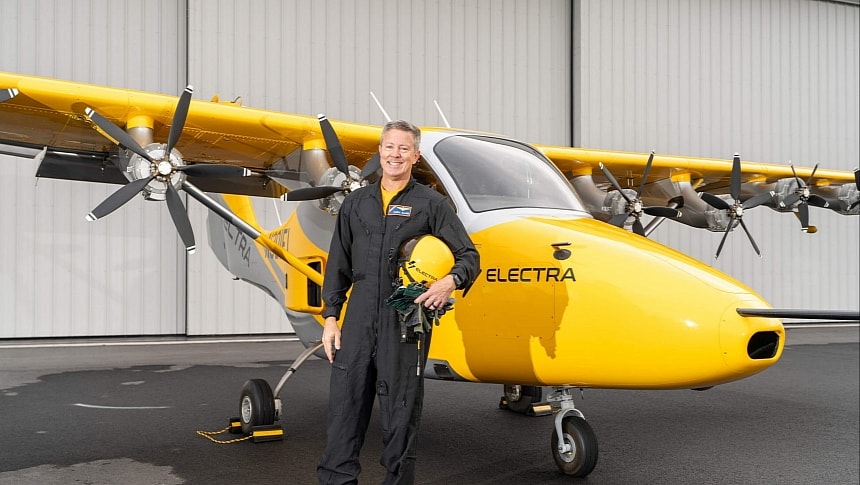The eSTOL (electric short takeoff and landing) developed by Electra could become a game-changer for military logistics. The US Army confirmed its potential by awarding the Northern Virginia-based company the funds that will accelerate its flight test program.
Electra has announced it will receive the funds to kick off wind tunnel testing of its hybrid-electric eSTOL, which is part of a complex flight test program for the technology demonstrator. Once this program is successfully completed, Electra will begin working on its production aircraft.
The full-scale demonstrator was officially unveiled last year, following tests with a sub-scale demonstrator that validated the blown-lift technology. The two-seat prototype was named Goldfinch and its first flight and it was an industry-first for hybrid-electric eSTOLs. The Goldfinch covered approximately 30 miles (482 km) during its pioneering flight in Virginia, using hybrid-electric propulsion.
The startup claims that its eSTOL is the first in the world to combine blown-lift technology (developed in-house) with distributed electric propulsion. Together with hybrid propulsion, this makes the Electra eSTOL considerably more advantageous compared to traditional aircraft, on the one hand, and battery-electric air taxis, on the other hand.
What makes this aircraft particularly attractive for the military is the fuel efficiency combined with the ability to takeoff and land from small spaces (150 feet/45.7 meters). This eSTOL could become a cost-effective alternative for military logistics in contested environments. Plus, the hybrid-electric propulsion enables range capabilities of more than 1,000 miles (1,600 km) without having to find and stop at battery charging stations (the batteries are recharged in flight).
In other words, the Electra eSTOL promises the range and payload of similar conventionally-powered aircraft (including helicopters) while burning considerably less fuel. Like most electric aircraft, it's also quieter. Additionally, its short takeoff and landing capability ensures its compatibility with contested environments.
The passenger version of this eSTOL will sport nine seats, which is almost double what most battery-electric air taxis can offer. With its high capacity, increased range, and cruising speed of 175 knots (324 kph), this low-emission aircraft has the potential to revolutionize regional air travel.
In less than four years, this startup made giant steps, which were also reflected in its market success. At the beginning of 2024, Electra had secured purchase agreements for more than 2,000 units of its flagship aircraft worth around $8 billion. In only a couple of years, its sales went from 500 to more than 2,000 units, thanks to a diverse range of worldwide customers.
This recent SBIR (Small Bussiness Innovation Research) contract worth $1.9 million will help this successful startup keep up the good work and move faster toward the production phase. The commercial version of the Electra eSTOL is set to enter service by 2028.
The full-scale demonstrator was officially unveiled last year, following tests with a sub-scale demonstrator that validated the blown-lift technology. The two-seat prototype was named Goldfinch and its first flight and it was an industry-first for hybrid-electric eSTOLs. The Goldfinch covered approximately 30 miles (482 km) during its pioneering flight in Virginia, using hybrid-electric propulsion.
The startup claims that its eSTOL is the first in the world to combine blown-lift technology (developed in-house) with distributed electric propulsion. Together with hybrid propulsion, this makes the Electra eSTOL considerably more advantageous compared to traditional aircraft, on the one hand, and battery-electric air taxis, on the other hand.
What makes this aircraft particularly attractive for the military is the fuel efficiency combined with the ability to takeoff and land from small spaces (150 feet/45.7 meters). This eSTOL could become a cost-effective alternative for military logistics in contested environments. Plus, the hybrid-electric propulsion enables range capabilities of more than 1,000 miles (1,600 km) without having to find and stop at battery charging stations (the batteries are recharged in flight).
In other words, the Electra eSTOL promises the range and payload of similar conventionally-powered aircraft (including helicopters) while burning considerably less fuel. Like most electric aircraft, it's also quieter. Additionally, its short takeoff and landing capability ensures its compatibility with contested environments.
The passenger version of this eSTOL will sport nine seats, which is almost double what most battery-electric air taxis can offer. With its high capacity, increased range, and cruising speed of 175 knots (324 kph), this low-emission aircraft has the potential to revolutionize regional air travel.
In less than four years, this startup made giant steps, which were also reflected in its market success. At the beginning of 2024, Electra had secured purchase agreements for more than 2,000 units of its flagship aircraft worth around $8 billion. In only a couple of years, its sales went from 500 to more than 2,000 units, thanks to a diverse range of worldwide customers.
This recent SBIR (Small Bussiness Innovation Research) contract worth $1.9 million will help this successful startup keep up the good work and move faster toward the production phase. The commercial version of the Electra eSTOL is set to enter service by 2028.








